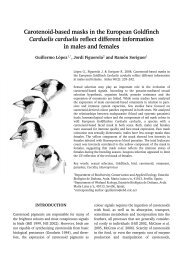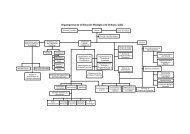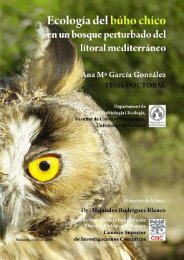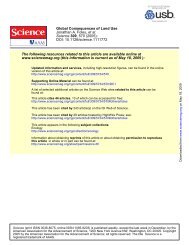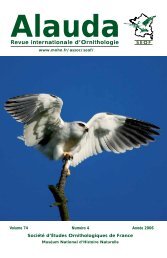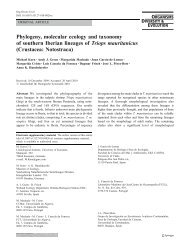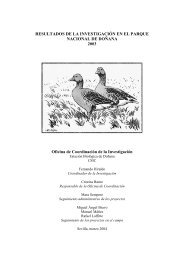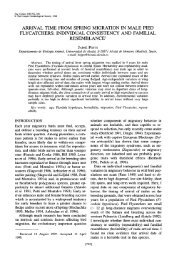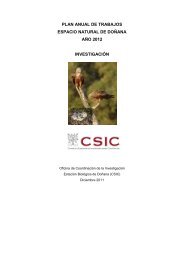Voucher Specimen Collection Preparation Identification and Storage ...
Voucher Specimen Collection Preparation Identification and Storage ...
Voucher Specimen Collection Preparation Identification and Storage ...
Create successful ePaper yourself
Turn your PDF publications into a flip-book with our unique Google optimized e-Paper software.
• Kill the dragonfly before inserting the envelope into the jar. This can be done by<br />
placing a few drops of ethyl acetate in the envelope. As soon as the insect is dead,<br />
the abdomen should be straightened <strong>and</strong> the envelope containing the dragonfly<br />
should be immersed in the acetone. If no poison is available, the envelope <strong>and</strong><br />
dragonfly can be placed in the acetone, killing the dragonfly. However, if this is<br />
done, the envelope will have to be removed from the jar after a minute or so, <strong>and</strong> the<br />
abdomen straightened if necessary, before replacing the envelope in the acetone.<br />
Otherwise, acetone-killed dragonflies will have curled abdomens, which are difficult<br />
to measure.<br />
• Leave the dragonflies in the acetone for at least 24 hours. The usual procedure is to<br />
take the envelope out for drying when the next day’s catch is ready to go into the<br />
jar(s). The acetone should be replaced after four or five uses; yellowish acetone<br />
indicates a change is necessary.<br />
• Drain acetone out of the envelopes <strong>and</strong> dry them in a well-ventilated place.<br />
• When the envelopes are dry they are stored in tupperware or cardboard boxes that<br />
will withst<strong>and</strong> crushing. Store the envelopes vertically, like a card file.<br />
• <strong>Specimen</strong>s can be shipped by mail in this manner. Simply make certain the box is<br />
nested in a larger box, protected on all sides by 7.5-10 cm of packing material.<br />
• Federal Transport of Dangerous Goods regulates the shipping of acetone <strong>and</strong> so it is<br />
best to get it after you arrive at your destination. Take the necessary jars or<br />
containers with you though, as it is may be hard to find a good jar with the right<br />
dimensions.<br />
• If you cannot use acetone, simply dry the specimens as rapidly as possible after they<br />
have been killed. Placing the boxes containing specimen envelopes at close range over or<br />
under electric lights is helpful. The faster the drying occurs, the better the colour<br />
preservation.<br />
• Another alternative is storage in 95% ethanol either in or without envelopes. If envelopes<br />
are not used, specimens can later be removed from the alcohol <strong>and</strong> dried in envelopes in<br />
the correct position. Both air drying (above) <strong>and</strong> ethanol treatment are less desirable than<br />
the acetone treatment.<br />
Preservation <strong>and</strong> Documentation<br />
Once specimens are brought to Royal BC Museum, they are removed from the glassine<br />
envelopes <strong>and</strong> store permanently in mylar envelopes (see below). Each mylar envelope<br />
contains only one specimen. <strong>Collection</strong> data are entered on computer <strong>and</strong> are printed out<br />
using a laser printer in a st<strong>and</strong>ard format (see below). The sheet is then cut into the proper<br />
labels (usually 3 from each page) <strong>and</strong> the labels are inserted in the envelopes behind the<br />
specimen. Any original determination labels are retained in the envelope behind the label.<br />
The envelopes are then stored vertically in cabinet drawers, much like a card file.<br />
Mylar envelopes: The envelopes are made of Mylar with a mono-molecular coat of<br />
cellophane, which allows heat sealing of the edges. The envelopes were originally designed<br />
by the Royal BC Museum <strong>and</strong> custom made by University Products, MA. University<br />
Products now carries them as a stock item in their catalogue.<br />
Labels: Printed on 8 ½” x 11” acid free heavy paper stock. This can be obtained from Crown<br />
Paper, Saanich, BC. Product #SRC 11433036, Curtis Britewater Text, 80 WT, 23” x 35” cut<br />
to 11” x 8 ½”.<br />
34 June 9, 1999




